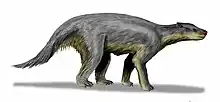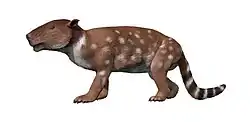Alcidedorbignya
Alcidedorbignya is an extinct pantodont mammal known from the Early Paleocene (Tiupampan SALMA, 65.5 to 61.7 million years ago) Santa Lucia Formation (18.0°S 65.6°W, paleocoordinates 20.7°S 52.5°W)[1] at Tiupampa near Mizque, Cochabamba, Bolivia.[2]
| Alcidedorbignya | |
|---|---|
| Scientific classification | |
| Domain: | Eukaryota |
| Kingdom: | Animalia |
| Phylum: | Chordata |
| Class: | Mammalia |
| Order: | †Pantodonta |
| Genus: | †Alcidedorbignya de Muizon and Marshall 1987 |
| Species: | †A. inopinata |
| Binomial name | |
| †Alcidedorbignya inopinata de Muizon and Marshall 1987 | |
Following a naming convention established by pioneering Argentine palaeontologist Florentino Ameghino (i.e. combining the first name and surname of a prominent scientist),[3] the genus name honours French naturalist Alcide d'Orbigny.[4]
Description
Estimated 25 cm head-body length and 500 grams, this was a small squirrel sized animal, terrestrial with possible scansorial habits, and either herbivorous or omnivorous.[5]
Alcidedorbignya is one of the oldest and most primitive of the pantodonts and the only pantodont genus known from South America.[2] Not only have some scientists[6] questioned the age of the type locality, instead advocating an Asian origin for the pantodonts, Alcidedorbignya's bare existence obscures the origins of the already enigmatic pantodonts.[2] Taxonomic similarities indicate that there was a mammalian interchange between North and South America during the early Paleocene,[7] and the North American pantodont Pantolambda is a potential descendant of Alcidedorbignya.[8]
Alciddedorbignya is known from several specimens of upper and lower dentitions, including juveniles. P3–4 have V-shaped ectolophs (ridges on the crowns), indicating it was a primitive pantodont. Other molar characteristics makes it unique among pantodonts. On the molars, the paracone and metacone are separated and not connate as in Bemalambda and Harpyodus. As in these two genera, there is neither a mesostyle on M1–2 nor a strongly V-shaped centocrista as in eupantodonts (all later pantodonts). It is still unclear which the primitive condition is in pantodont upper dentition, and the position of Alcidedorbignya near the base of the clade remain unresolved.[2][9]
References
- Tiupampa site 1, the “quarry” (Paleocene of Bolivia) in the Paleobiology Database. Retrieved 14 July 2013.
- Muizon & Marshall 1992, Abstract
- Rose 2006, p. 230
- "Alcidedorbignya". Paleofile.com. Archived from the original on 2015-02-14. Retrieved 14 July 2013.
- Darin, Croft. Horned Armadillos and Rafting Monkeys. p. 30.
- E.g., Lucas 1998, p. 281 disputed the Cretaceous age first proposed by Muizon & Marshall 1987.
- See First American land bridge
- Gayet, Marshall & Sempéré 1991, pp. 419, 423
- Rose 2006, pp. 114–5
Bibliography
- Gayet, Mireille; Marshall, Larry G.; Sempéré, Thierry (December 1991). "The Mesozoic and Paleocene Vertebrates of Bolivia and Their Stratigraphic Context: A Review" (PDF). Revista Técnica de YPFB. 12 (3–4): 393–433. OCLC 713096841. Retrieved 14 July 2013.
- Lucas, Spencer G. (1998). "Pantodonta". In Janis, Christine Marie; Scott, Kathleen Marie; Jacobs, Louis L. (eds.). Evolution of Tertiary Mammals of North America: Terrestrial carnivores, ungulates, and ungulatelike mammals. Vol. 1. Cambridge University Press. ISBN 9780521355193.
- McKenna, Malcolm C.; Bell, Susan K. (1997). Classification of Mammals Above the Species Level. New York: Columbia University Press. ISBN 0231110138. OCLC 37345734.
- Muizon, Christian, de; Marshall, Larry G. (1992). "Alcidedorbignya inopinata (Mammalia: Pantodonta) from the Early Paleocene of Bolivia: Phylogenetic and Paleobiogeographic Implications". Journal of Paleontology. 66 (3): 499–520. doi:10.1017/S002233600003403X. JSTOR 1305874. OCLC 4908683665.
{{cite journal}}: CS1 maint: multiple names: authors list (link) - Muizon, Christian, de; Marshall, Larry G. (1987). "Deux nouveaux condylarthres (Mammalia) du Maastrichtien de Tiupampa (Bolivie)" (PDF). Comptes rendus de l'Académie des sciences. 304 (15): 947–950.
{{cite journal}}: CS1 maint: multiple names: authors list (link) - Rose, Kenneth David (2006). The beginning of the age of mammals. Baltimore: JHU Press. ISBN 0801884721.

